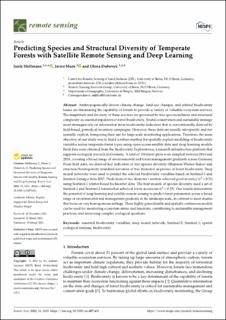| dc.description.abstract | Anthropogenically-driven climate change, land-use changes, and related biodiversity losses are threatening the capability of forests to provide a variety of valuable ecosystem services. The magnitude and diversity of these services are governed by tree species richness and structural complexity as essential regulators of forest biodiversity. Sound conservation and sustainable management strategies rely on information from biodiversity indicators that is conventionally derived by field-based, periodical inventory campaigns. However, these data are usually site-specific and not spatially explicit, hampering their use for large-scale monitoring applications. Therefore, the main objective of our study was to build a robust method for spatially explicit modeling of biodiversity variables across temperate forest types using open-access satellite data and deep learning models. Field data were obtained from the Biodiversity Exploratories, a research infrastructure platform that supports ecological research in Germany. A total of 150 forest plots were sampled between 2014 and 2018, covering a broad range of environmental and forest management gradients across Germany. From field data, we derived key indicators of tree species diversity (Shannon Wiener Index) and structural heterogeneity (standard deviation of tree diameter) as proxies of forest biodiversity. Deep neural networks were used to predict the selected biodiversity variables based on Sentinel-1 and Sentinel-2 images from 2017. Predictions of tree diameter variation achieved good accuracy (r2 = 0.51) using Sentinel-1 winter-based backscatter data. The best models of species diversity used a set of Sentinel-1 and Sentinel-2 features but achieved lower accuracies (r2 = 0.25). Our results demonstrate the potential of deep learning and satellite remote sensing to predict forest parameters across a broad range of environmental and management gradients at the landscape scale, in contrast to most studies that focus on very homogeneous settings. These highly generalizable and spatially continuous models can be used for monitoring ecosystem status and functions, contributing to sustainable management practices, and answering complex ecological questions. | en_US |

